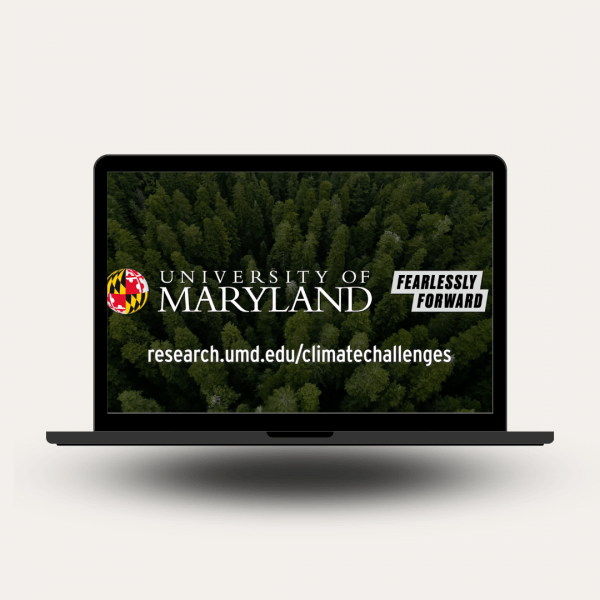Rising to a Grand Challenge: Climate-Related Disasters, Farming Crises
Institutional Grant Team Works to Provide Early Warning in Maryland, Beyond.
With no warning, rising water in historic Ellicott City, Md., in July 2016 crashed through homes and businesses, collapsed historic buildings, carried off cars and killed two people. Another supposedly thousand-year flood struck less than two years later: More than 8 inches of rain fell in three hours, turning the town’s main street into a raging torrent and sweeping a man trying to rescue a stranger to his death.
Science has shown that an increasingly unstable climate is making such extreme weather more and more likely, and as Ellicott City’s troubles demonstrate, such climate-related disasters aren’t taking place only on remote coastlines or polar regions, but are homegrown.
Now, a multidisciplinary group of researchers focused on Earth system science and global change is preparing to leverage the latest scientific tools and discoveries in their fields to meet the existential threats of climate change in Maryland head-on. Funded by a three-year, $3 million Grand Challenges Institutional Grant, an initiative known as Addressing Climate Change for a Sustainable Earth will work with federal partners like NASA and the NOAA as well as the state to develop systems capable of providing early warning to residents that climate-related flood, tornadoes and other weather disasters are imminent. Using satellite data, ground-based sensors and other tools, the team will also work to deliver information to Maryland farmers and agribusinesses to help shield food production from changing climate.
The team is a collaboration between the departments of Atmospheric and Oceanic Science, Geology and Geographical Sciences, as well as the Earth System Science Interdisciplinary Center (ESSIC) and the Marine Estuarine Environmental Sciences graduate program.
Led by Ellen Williams, Distinguished University Professor of physics and ESSIC director, the initiative was constructed to encompass all the connections of climate change—from how the oceans store carbon to atmospheric reactions near the boundary of outer space to human impacts on ecosystems. The project is also designed to provide deep experiential learning to students through courses and internships and could eventually lead to the creation of a new UMD school or college for translating Earth science and climate science research into potentially life-saving action for the region, nation and world.
“When we say climate change, it’s not just that we’re getting a little warmer,” Williams said. “It’s that our whole weather system is changing and it’s going to affect our farming, our flooding and our daily lives in really dramatic ways.”
{"preview_thumbnail":"/sites/geog.umd.edu/files/styles/video_embed_wysiwyg_preview/public/video_thumbnails/guRDGjAjdhw.jpg?itok=wI-vEI26","video_url":"https://youtu.be/guRDGjAjdhw","settings":{"responsive":1,"width":"854","height":"480","autoplay":0},"settings_summary":["Embedded Video (Responsive)."]}
While UMD is a leader in studying and understanding the processes of global warming and ways to slow it, the Grand Challenges Grants Program-funded project is all about taking action now, said the team members.
“This project is going to focus on converting and translating research to implementation,” said Tatiana Loboda, chair of the Department of Geographical Sciences. “This is really the main thrust—we're taking the scientific findings that our faculty produce and converting them to policy, to decision making, to specific tools that enable those processes to take place.”
One component of the initiative will be the Maryland Mesonet system, a planned world-class system of 75 weather stations around the state to provide early warning of danger. The system, a partnership between the state and university, was announced last fall along with a $4 million state grant to help build it.
“Temperature, pressure, humidity, rainfall and snow data will be collected, as will soil moisture at various depths, to help develop warnings for extreme weather, including floods,” Professor Sumant Nigam, chair of the Department of Atmospheric and Oceanic Science and principal investigator of the Maryland Mesonet project said at the time of the announcement. “In addition, we will monitor incoming solar radiation, wind speed and wind direction at high space-time resolution, collecting critical data for the state’s green energy industry.”
The project also includes studying how to best communicate rapidly evolving findings, particularly when they involve public safety.
Other team members include Timothy Canty, associate professor of atmospheric and oceanic science and the director of Marine Estuarine Environmental Sciences, and James Farquhar, Distinguished University Professor and chair of the Department of Geology.
Although even localized, limited disasters like those in Ellicott City can make the power of climate change seem almost insurmountable, researchers at the University of Maryland and elsewhere are steadily creating solutions for this greatest of societal challenges, Williams said.
“With all of us working together to slow the progression of climate change, we will ultimately solve these problems and save our world,” she said.
By Chris Carroll
This story originally appeared in Maryland Today.
Main image: screenshot from the video "Tackling Grand Challenges: Addressing Climate Change for a Sustainable Earth"
Published on Wed, 04/26/2023 - 13:48


